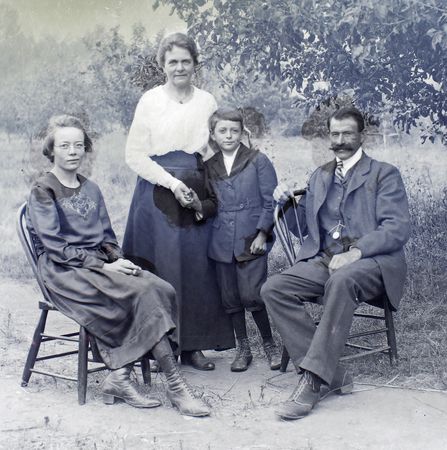
 604 465 4322
604 465 4322General Store Site 12294 Harris Road Pitt Meadows, B.C.
Click Here for Directions& Visiting Hours

Looking Back: The history of a Park
Looking back article January 29th 2020.
*The image features the Hoffmann family, Ladislaus, Hans, Emilie, and Elfride posed for an image likely at Aldergrove, B.C. orchard c. 1918.
With snow in January has also come a flurry of activity for the two Museum sites in preparation for moves necessitated by the Harris Road underpass. Some of that activity has been a topographical survey of the Museum Society’s land in Hoffmann Park. Here now is a little history of that park.
At the centre of the highland area of Pitt Meadows is an urban green space known today as Hoffmann Park. The Park is made up of trees, trails, an off-leash area, and four heritage buildings including the Hoffmann & Son shop, but the use of the site is much older than the buildings that occupy it.
On November 30, 1863 John McKenney and James Lindsay, both Royal Engineers, applied for a land grant for 160 acres of property in the area. The grant was awarded on August 30, 1871, two months after BC joined confederation. They held the property for speculative purposes only, and sold it on to Hugh Ross in 1873. Ross passed away soon after, starting a court battle between his widow and William Manson who claimed to have purchased the property from Ross before his death. Manson proved victorious and received title to the land in 1889, eventually transferring it to Joseph Lowther Wilson, a member of the Seventh Day Adventist Church, in 1903. In 1908 Wilson transferred the property to the Church as part of the process of Seventh Day Adventist Colonization in Pitt Meadows. On the portion that now makes up Hoffmann Park, the Church built a three-story Adventist School, and further south, at what is now Ford Road, they built a little church. The remainder of the land was reserved for colonists and their farms.
Adventist colonization in Pitt Meadows ended when WWI began, and by the early 1920’s the Church’s land was sold with the new owner of the portion that would become Hoffmann Park, Noble Grant Knotts, holding it for speculative purposes. By 1928 it was sold on to Jack Fairfield who then built the first garage on the property, and, also, a small house just to the north of it. This little house would, for many years, also serve as the local pool hall.
In May 1934, Ladislaus Hoffmann took possession of the land, having traded Jack Fairfield his orchard in Aldergrove for the property. This trade gave Ladislaus and Emilie Hoffmann’s 22-year-old son Hans an opportunity to use his new skills as a mechanic, and, in 1936, they built the shop that presently occupies the site. In 1944 a new family home was built on the south side of their property and in the early 1950’s the Quonset hut at the back of the site was constructed to house the large equipment that was used in the ditching and drainage business Hans had started in the 1940’s. Ladislaus died in the 1952 and Emilie in 1970, and soon after, Hans and his sister Elfriede saw the need to divest themselves of some of the acreage and over the course of a decade they sold land to the District of Pitt Meadows. This is the area we know today as the core of Hoffmann Park. In September 1999, the acre of land that makes up the Hoffmann & Son site of the Museum was donated to the Museum Society, and a few years later the acre of land with the Hoffmann’s house was donated to the municipality.
With the building of an underpass on Harris Road there will be changes to the two acres of Hoffmann land that fronts Harris Road -- stay tuned.
Leslie Norman, Pitt Meadows Museum





